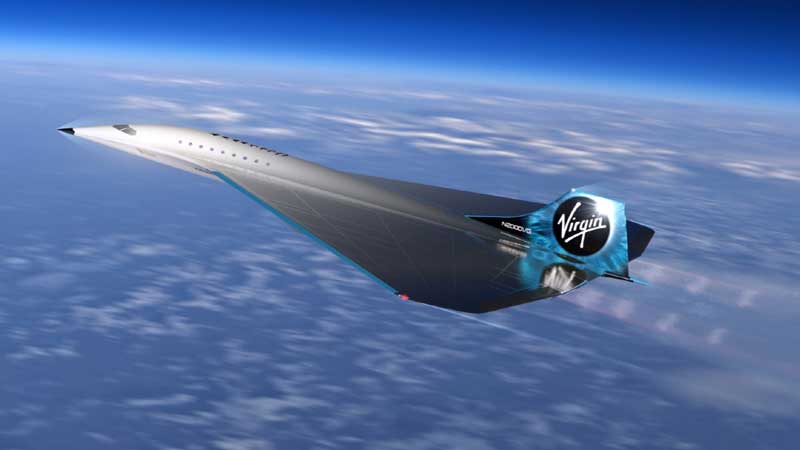Virgin Galactic Reveal Plans for New Supersonic Jet
Sir Richard Branson’s ambitious plans to operate a global superfast supersonic airline service are a step closer to reality after his company’s recent announcement. Virgin Galactic revealed their design for the new super jet on August 3rd 2020.
Not only have these ambitious plans been released, but the company have also signed an agreement with the major international engine manufacturer Rolls Royce to design and construct the engines which will be used to power the plane. Rolls Royce also provided the engines for the now retired Anglo-French Concorde aircraft. This was the only previous passenger carrying supersonic jet design, so they have a unique track record in producing such cutting edge supersonic capable engines.
The concept is no pie in the sky fantasy either. Not only do Rolls Royce have previous practical experience in such designs, but the US space agency NASA were also involved in the plans. Furthermore, George Whitesides, the Chief Space Officer at Virgin Galactic who made the announcement, added that the company is also already in talks with the US Federal Aviation Authority (FAA). This should ensure that the plane can begin to operate as soon as it is cleared for take-off.
The basic design proposal involves manufacturing a delta wing jet which will be able to carry up to nineteen people over very long distances. The aircraft will be designed to travel at a maximum speed of around three times the speed of sound (Mach 3), or about 2,300 miles per hour. It will be designed to ‘cruise’ at 60,000 feet. This is twice as high as current commercial jets are designed to fly, and is close to the currently defined boundaries of space. The new plane will certainly be travelling high enough for its passengers to observe the curvature of the Earth. The sky should appear to be a very dark inky blue, if not almost black.
Flying at this unprecedented speed and altitude should enable the new jet to carry passengers from London to New York in less than a couple of hours. Even London to Sydney should be possible in just five hours, assuming the craft will be capable of carrying sufficient fuel to make the journey without stopping.
The aircraft is also intended to be able to use a more sustainable form of aviation fuel, in order to minimise its effect on the environment. It is also proposed that the new plane will take off and land just as any currently operating aircraft does, using existing commercial airports.
There is still quite a way to go though. The next stage of the design process involves designing specific aircraft systems, determining the actual materials to be used in its manufacture and refining its specifications. Heat management, exhaust emissions, maintenance schedules and economic viability are just some of the issues which will need to be resolved at this stage. Plus of course, the noise these aircraft will produce will need to be assessed. Engine noise and the sonic boom produced when aircraft break the sound barrier proved to be major problems for the now retired Concorde fleet.

The supersonic jet will carry passengers from London to Sydney in 5 hours
Other Practical Problems
There are a few other practical issues which will need to be overcome too. For a start, this is no mass market design. With a maximum passenger capacity of just nineteen, this will be more like an executive jet than a jumbo. The emphasis will be on First Class and Business customers, not holidaymakers travelling in Economy on a budget. In fact, early return ticket prices may not be far short of those required for Virgin Galactic’s sub-orbital space service, which are currently priced at more than $250,000.
There is also the practical difficulty of the time differences involved in inter-continental travel. Given that the service seems to be aimed at business travellers and wealthy day-trippers, the time zones crossed on such flights may make these kinds of journeys unattractive. Whilst it is true that a return trip to just about anywhere on Earth can theoretically be completed in one day, it would certainly be a very strange day.
If, for example, your time poor executive were to leave New York at 6am, they would arrive in London at around 2pm UK time. No doubt there would be a superfast VIP check-out procedure, but that still wouldn’t leave much time left in the working day for those vital business meetings. Maybe our busy executive could leave earlier, but there would be little time for sleep on a two hour journey.
The situation works better for a UK based business mogul travelling to New York, because of the reverse time differences, but it would be a very long ‘day’. It also works better on longer distance routes, where the ‘day-trip’ option does not really apply.
Given the likely ticket prices and low passenger capacity, maybe the future of these aircraft lies in the executive jet market. These supersonic aircraft may just be the future ‘must have’ equivalent of today’s superyachts.
The Future
This may well be a ground-breaking development, but remember that these aircraft are not expected to begin service until the 2030s at the earliest. This means that at least there is plenty of time to start saving up for your ticket. Maybe that charter flight to Disneyland or to see the Super Bowl could be within reach. And that once in a lifetime trip across the world to see your long lost relatives in Australia will at least be a lot more comfortable and swift.
